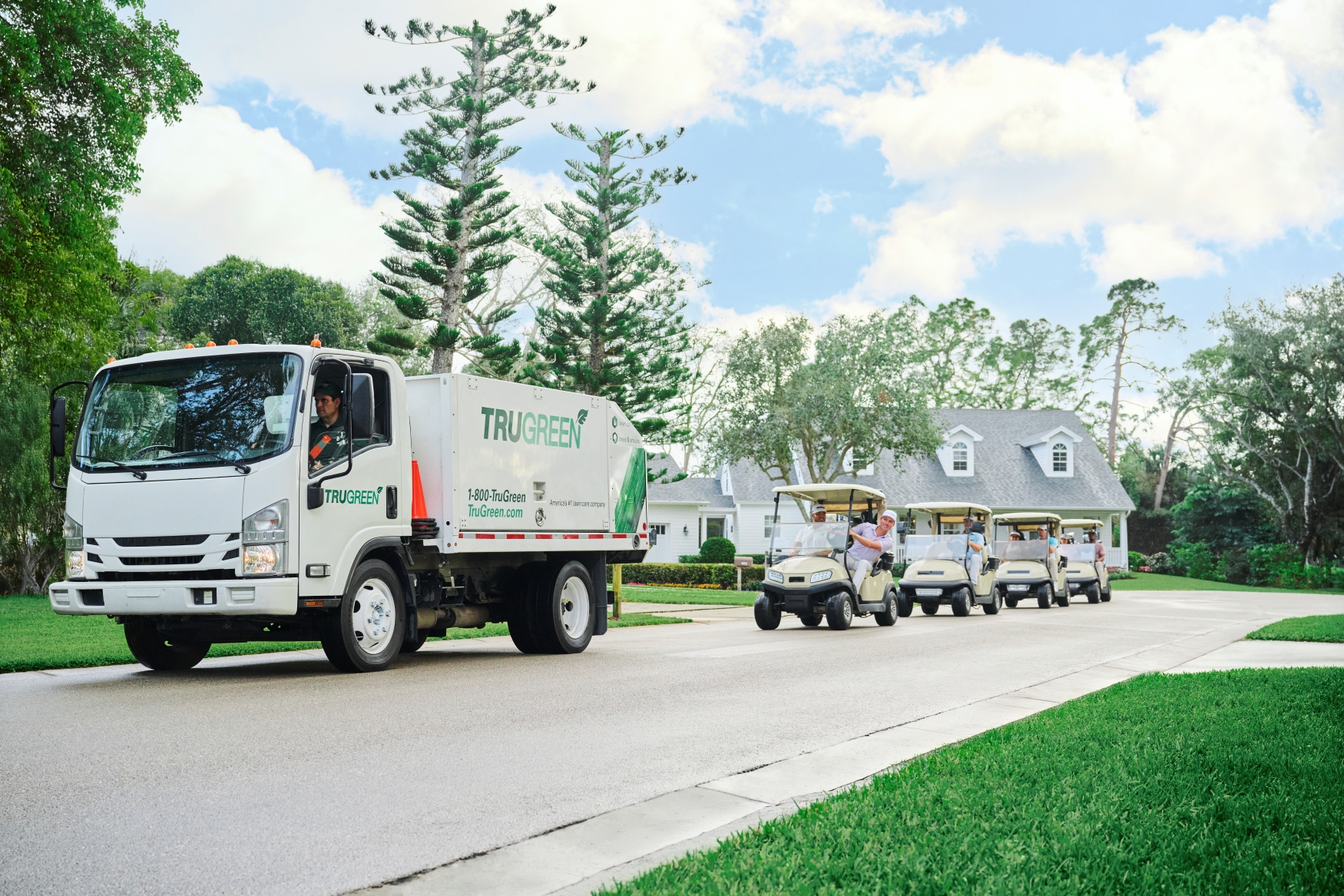Mow Like a Pro: The right mowing height makes all the difference. For cool season grasses like Kentucky Bluegrass and Fescue, keep your mower a bit higher (around 2.5 to 4 inches) to help retain moisture and encourage deep roots. For warm season grasses like Bermuda and Zoysia, mow shorter (1 to 2.5 inches) to keep them dense and resilient during the hot summer months. Mowing at the proper height helps your lawn thrive year-round.
Fertilize Regularly: Fertilizing regularly is vital to keep your lawn nourished and green. TruGreen’s fertilization plans use a mix of slow-release and quick-release fertilizers which provides your lawn with the essential nutrients it needs to stay strong, healthy and lush all season long. This ensures your grass gets what it needs at just the right time for maximum growth.
Water Smarter: Watering deeply and early in the morning is key to a strong, healthy lawn. It promotes deep root growth, minimizes evaporation and helps reduce fungal diseases by allowing the sun to dry the blades before spores have a chance to spread. And a little reminder: don’t water at night. Wet blades in the dark are perfect breeding grounds for fungi.
Effective Strategies for Smart Irrigation:
- Deep, Infrequent Watering: Water deeply (about 1 inch per week) to promote root growth. Use a rain gauge or a straight-sided container to measure accurately.
- Water Early: Irrigate in the morning to minimize evaporation and prevent fungal growth.
- Use Smart Controllers: Advanced irrigation systems with smart controllers adjust watering schedules based on weather, soil moisture and evaporation rates — much like the technology used on golf courses. This ensures optimal water use, preventing over-watering and ensuring even growth across your lawn.
Aeration Is the Real MVP: Your lawn’s soil needs some breathing room to thrive, and aeration is the way to make it happen. By punching holes into compacted soil, aeration allows air, water and nutrients to sink deep, giving your grass the boost it needs to grow stronger and healthier. As a rule of thumb, you should aerate your lawn annually — especially if the soil feels unusually compacted.
Take a tip from golf courses, which often aerate multiple times a year to handle high-traffic areas like greens and tees. If you’re not sure when or how often your lawn needs it, a lawn care expert can assess its condition and recommend the perfect aeration schedule. TruGreen’s aeration service removes the guesswork, creating the ideal environment for your grass to flourish. Think of it as giving your lawn the VIP treatment it deserves.
Overseeding Is Key: Particularly for cool-season grasses, overseeding is the secret to transforming your lawn — filling in bare spots and building resilience against pests and diseases. Here’s the winning strategy: combine overseeding with aeration. Aeration opens up the soil, giving seeds the ideal space to settle and grow deep, healthy roots. If you have cool-season grasses, TruGreen’s overseeding service will get you the right seed mix for your lawn’s unique needs, ensuring it looks and performs like a pro.
But how do you know your grass needs overseeding? Ask yourself: "Does my grass turn brown in the winter, or does it stay green?"
If it turns brown, you have warm-season grass and should focus on aeration. If it stays green, you have cool-season grass and can benefit from both aeration and overseeding. This simple question can guide your lawn care approach no matter where you live.
Here’s a breakdown:
Cool-Season Grasses:
Benefit most from both aeration and overseeding in the fall. Overseeding during this time allows seeds to settle into aeration holes, promoting easy germination and healthy growth as the grass enters its peak growing season.
Warm-Season Grasses:
Best for aeration only, with optimal timing in late spring or early summer. Overseeding is generally not recommended for warm-season grasses. Most of these grasses are grown from plugs, sprigs or sod instead of seed, and their seeds are slow to germinate and become established in comparison to cool-season grasses.
Tips for Successful Overseeding
- Know Your Grass Type: Overseeding timing and techniques differ between cool-season grasses. Ensure you match your approach to the specific needs of your lawn.
- Prep the Lawn: Mow shorter than usual and remove clippings to ensure better seed-to-soil contact.
- Spread Evenly: Use a spreader to distribute seeds uniformly across the lawn.
- Water Consistently: Lightly water twice daily until new grass is established.
- Be Patient: Overseeding is an investment in your lawn’s long-term health, so give new grass time to grow and strengthen.
Learn Lawn Tech: Tricks from the Pros
Golf courses use advanced tools like heat mapping to monitor soil temperature and moisture, fine-tuning their care with pro-level precision. While your backyard might not need such high-tech wizardry, the concept works wonders for any lawn.
By paying attention to your lawn’s microclimates — like sunny spots, shady corners or wind-prone patches — you can tweak your watering and maintenance for maximum impact. It’s the perfect personalized lawn care: sunny areas may need extra hydration, while shaded spots can get by with less. Adjusting your approach to match your lawn’s unique quirks keeps it thriving, efficient and ready for any backyard game of soccer or Friday night barbeque with the family.


 Branch Finder
Branch Finder















 Back to all blogs
Back to all blogs

Facebook
X
Youtube
Copy Link
Email